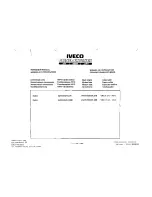
rpms) with the high-speed needle valve
and then performing idling (low speed
rpms) with the throttle valve and the
low-speed needle valve. (Unless peak
rpm is achieved, idling adjustment will
be difficult to adjust and will not be
stable.)
• After filling the tank, start the engine
and move the throttle to the fully
open position.
• Turn the main needle valve screw
clockwise (refer to Figure 5, page
7) with the carburetor adjustment bar
(provided in accessories package)
or a small screw driver, and adjust to
achieve peak rpm. Use a tachometer
to verify rpm.
CAUTION:
Over-closing the main
needle valve is very dangerous
because it may cause knocking and
predetonation. It may also cause the
propeller nut to loosen. Immediately
turn the main needle counterclockwise
to richen up the setting.
• Next, close the throttle valve until
the engine operates stably and with
an idle rpm of around 1,700 rpm, by
adjusting the low-speed needle
valve with the carburetor adjustment
bar (or small screwdriver) and
manipulation of the throttle valve via
the throttle stick on the transmitter.
• After reaching the stable 1,700 rpm,
slowly open the throttle fully. If the
rpms become slow or go up suddenly,
adjust carefully until the changes
are smooth from idle to peak rpm, by
adjusting the low-speed needle valve.
• After the previous steps have been
accomplished, repeat the process
from idle to high rpm quickly. If the
rpms do not reach peak, but stutter as
the throttle moves from low to high,
re-tune the main needle valve and
perform the process from idling to
peak quickly.
• Repeat the process until the response
is a smooth transition from idle to
peak rpm.
Factory settings for the main and low-
speed needle valves are as follows:
• Main needle valve: Turn needle valve
all the way clockwise and then back
out 2 1/3 turns.
• Idle needle valve: Turn the needle
valve all the way clockwise and then
back out 4 turns.
• Set the throttle barrel at the fully
closed position before making any
adjustments.
N O R M A l O P E R A T I O N A N D M A I N T E N A N C E
11
10
A D J U S T M E N T O F T h E C A R B U R E T O R
General Operating
Proceducres
to ensure the long life of the engine:
• Do not operate the engine with a
“lean” mixture.
• Regularly check all screws and nuts
on both the engine and muffler.
• After 1 to 2 hours of operation,
valve adjustment may be necessary.
Adjust the valves as shown in the
Engine Maintenance and Valve/
Tappet Adjustment Sections.
• The Saito engines are
equipped with a “breather” nipple.
It is recommended that a length of
Tygon type tubing be attached to this
crankcase breather nipple and routed
away from the engine compartment
so the excess oil can be expelled
outside of the aircraft.
Normal Operation,
Maintenance and
Additional Information
• Be sure to do a range check before
flying your model. It would be wise
to do the range check with the engine
running and without it running.
As a simple noise check, after the
engine is started, lower the antenna
of the transmitter and operate it
about 60 yards from the airplane.
If there is no malfunction noted, it is
normal.
• Be sure to charge the ignition battery
and radio system battery before the
first flight of the day.
• To discharge the waste oil, connect
a gasoline-proof line from the
breather nipple on the crankcase and
vent it outside of the aircraft.
• Lubrication of the piston, connecting
rod, bearings and cam gear is blow-
by lubrication, in which the oil in
the fuel goes into the crankcase from
the clearance between the cylinder
and the piston. Engine life is directly
affected by the property of the fuel/
oil mix. Please use reliable oil.
• Running the engine too lean causes
heat; be sure to run the engine
slightly “rich” from peak. Running
too lean will cause “knocking”
or engine failure and has an adverse
effect on the connecting rod and the
cam gear.
• Adjustment of the tappet is described
in the “Valve/Tappet Gap
Adjustment” section.
• When attaching an exhaust
pipe to the cylinder or attaching a
propeller nut, the use of threadlock is
recommended.






























